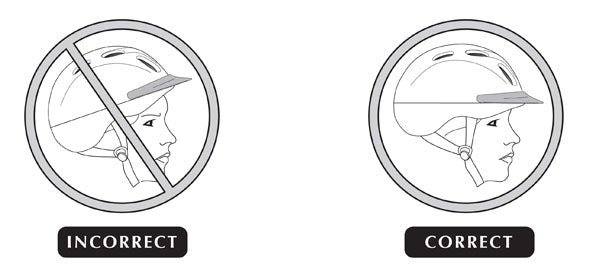Fitting your helmet correctly is as important as wearing one. Fortunately, fitting your helmet can be done in three easy steps.
STEP 1: FIND THE CORRECT SIZE
Using a fitting chart, narrow down which helmets to try (you can use your hat size as a guide, if you know it, or measure around your head to get a size in inches or centimeters) and then just start sampling helmets to see how they feel.
To be effective, the helmet must fit firmly but comfortably. A helmet that is too loose may shift position as you ride, possibly reducing the helmet’s protective potential, and one that fits too tightly may cause discomfort.
The helmet should sit level on your head, with the front edge just above your eyebrows. (See illustration)

The helmet should not easily roll forward or backward. When you do move the helmet, it should move the skin around your eyebrows. If the skin doesn’t move, the helmet is likely too large. The helmet should feel snug around the entire head without pressure points.
If you feel gaps between your head and the side of the helmet, remove the helmet and engage the Flip-Fold™ pads in the areas that have gaps by folding the pads under to connect with the hook and loop fasteners on the inside of the helmet. Smooth the helmet liner with your hand, and try the helmet on again. If the helmet still feels too loose, consider a smaller size.
Buy the helmet size you need now--don’t plan to grow into your helmet. When you think you have the right size, bow deeply with the retention system unbuckled. If the helmet feels like it may fall off, you may need a smaller size.
STEP 2: ADJUST THE FIT
After the helmet fits the crown of the head snuggly, it is time to adjust the retention system. Proper adjustment of the fit pads and retention system should be checked each time you wear the helmet to be sure your adjustments have not changed, but generally, once the retention system is adjusted properly, you won’t have to adjust it much more.
All Troxel helmets have a retention system made of webbing and quick-release buckles, and most also have a GPS™ (Gripper Positioning System) stabilizing system. The retention system wraps through the helmet and around your chin to keep the impact absorbing part of the helmet properly fastened on your head in case of an accident. In contrast, a GPS™ simply holds the helmet comfortably in place while in use. The retention system is essential to the protective function of your helmet. This retention system works independently of the
GPS™ system. The GPS™ is not part of the safety of your helmet, nor is it part of the ASTM testing of your Troxel helmet.
Fasten the chinstrap buckle. Adjust each slide glide so that it sits directly below the ear, as in the illustration below.

Next, adjust the webbing next to the male end of the buckle until there is no slack in the strap and fits snugly under your jaw without causing discomfort. You should only be able to fit two fingers between the strap and under the chin. If you yawn, you should feel the retention straps pull the helmet down on the top your head more.
Once the straps are the correct length, pass the loose ends through both of the two rubber o-rings and move the outside o-ring to the end of the strap. See the illustration below.

Please note that the ends of the straps may be of different lengths due to the individual adjustment of the slide guides.
If there is a GPS system in your helmet, this is the time to adjust it until you feel it snug against the back of the head. Turn the dial of your GPS II up to three clicks or pinch the black buttons on the back of your GPS III to reduce the space between the GPS system and your neck. Note: for the GPS III, taking the helmet off and using both hands can make adjustment easier. Place both of your thumbs on the arch of the GPS III and apply gentle, even pressure as you adjust the two buttons toward the center. Excessive force can cause the GPS III to disconnect from the helmet, as it is designed to do in the case of an accident.
STEP 3: CHECK YOUR WORK
A proper-fitting helmet will feel firmly-connected to the crown of your head with evenly-distributed snugness in the retention system. There should not be any pressure points. With the chinstrap still securely fastened, the helmet should not move significantly if you tried to roll it off your head. If you can, the helmet is too big. Troxel stresses the importance of snugly adjusting and buckling the retention system for every ride. Troxel helmets utilize a simple, quick release buckle retention system that, once adjusted, can be buckled and unbuckled without changing the adjustment.



